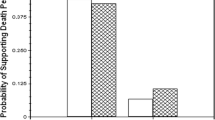Abstract
Subjects individually read a description of either a moderately aggravated or a severely aggravated murder and were informed that the defendant had already been convicted of first degree murder. Their task was to decide on the penalty of life imprisonment versus death. Subjects then read summaries of the prosecution and defense penalty arguments, after which they either read or did not read a statement describing the impact of the victim’s death on the victim’s family. Significantly more subjects exposed to the victim impact statement voted for death than those not exposed to the statement. Victim impact evidence led to increased numbers of subjects voting for death for both crimes, and victim impact evidence had its strongest effects on individuals who already favored the death penalty.
Similar content being viewed by others
References
Ashworth, A. (1993). Victim impact statements and sentencing.The Criminal Law Review, July, 498–509.
Baldus, D., Woodworth, G., & Pulaski, C. (1990).Equal justice and the death penalty: A legal and empirical analysis. Boston, MA: Northeastern University Press.
Blankenship, M.B., Luginbuhl, J., Cullen, F.T., & Redick, W. (in press). Juror comprehension of sentencing instructions: A test of Tennessee’s Death Penalty Process.Justice Quarterly.
Brehm, S. S., & Kassin, S. M. (1989).Social psychology. Boston: Houghton Miflin.
Costanzo, M., & Costanzo, S. (1992). Jury decision making in the capital penalty phase: Legal assumptions, empirical findings, and a research agenda.Law and Human Behavior, 16, 185–202.
Costanzo, S., & Costanzo, M. (1994). Life or death decisions: An analysis of capital jury decision making under the special issues sentencing framework.Law and Human Behavior, 18, 151–170.
Cowan, C. C., Thompson, W. C., & Ellsworth, P. C. (1984). The effects of death qualification on jurors’ predisposition to convict and on the quality of deliberation.Law and Human Behavior, 8, 53–80.
Coyne, R. (1992). InflictingPayne on Oklahoma: The use of victim impact evidence during the sentencing phase of capital trials.Oklahoma Law Review, 45, 589–628.
Davis, R.C., & Smith, B. E. (1994). Victim impact statements and victim satisfaction: An unfulfilled promise?Journal of Criminal Justice, 22, 1–12.
Diamond, S.S. (1993). Instructing on death: Psychologists, juries, and judges.American Psychologist, 48, 423–434.
Eisenberg, T., & Wells, M. T. (1993). Deadly confusion: Juror instructions in capital cases.Cornell Law Review, 79, 1–17.
Eisenberger, N., & Miller, P.A. (1987). The relation of empathy to prosocial and related behaviors.Psychological Bulletin, 101, 91–119.
Ellsworth, P.C., & Gross, S.R. (1994). Hardening of the attitudes: Americans’ views on the death penalty.Journal of Social Issues, 50, 19–52.
Fincham, F.D. (1982). Moral judgment and the development of causal schemes.European Journal of Social Psychology, 12, 47–61.
Fitzgerald, R., & Ellsworth, P. (1984). Due process vs. crime control: Death qualification and jury attitudes.Law and Human Behavior, 8, 31–52.
Geimer, W., & Amsterdam, J. (1988). Why jurors vote life or death: Operative factors in ten Florida death penalty cases.American Journal of Criminal Law, 15, 1–54.
Gillers, S. (1980). Deciding who dies.University of Pennsylvania Law Review, 129, 1–124.
Haney, C. (1984). On the selection of capital juries: The biasing effects of the deathqualification process.Law and Human Behavior, 8, 121–132.
Luginbuhl, J., & Burkhead, M. (1994). Sources of bias and arbitrariness in the capital trial.Journal of Social Issues, 50, 103–124.
Luginbuhl, J., & Howe, J. (1995). Discretion in capital sentencing instructions: Guided or misguided?Indiana Law Journal, 70, 1161–1181.
Luginbuhl, J., & Middendorf, K. (1988). Death penalty beliefs and jurors’ responses to aggravating and mitigating circumstances in capital trials.Law and Human Behavior, 12, 263–281.
Mosteller, R. P. (1993). The effect of victim-impact evidence on the defense.Criminal Justice, 8, 24–64.
Packer, H. (1968).The limits of the criminal sanction. Stanford, CA: Stanford University Press.
Vital, V.D. (1994).Payne v. Tennessee: The use of victim impact evidence at capital sentencing trials.Thurgood Marshall Law Review, 19, 497–534.
Walster, E. (1966). Assignment of responsibility for important events.Journal of Personality and Social Psychology, 3, 73–79.
Cases Cited
Booth v.Maryland, 482 U.S. 496 (1987).
Gardner v. Florida, 430 U.S. 349, 362 (1977).
Gathers v.South Carolina, 490 U.S. 805 (1989).
Payne v. Tennessee, 498 U.S. 29 (1991).
Wainright v. Witt, 469 U.S. 412 (1985).
Witherspoon v.Illinois, 391 U.S. 510 (1968).
Author information
Authors and Affiliations
Corresponding author
Additional information
Appreciation is extended to Sara Wrenn who conducted some of the experimental sessions, and to Rich Rosen for his helpful comments on an earlier version of the manuscript.
Rights and permissions
About this article
Cite this article
Luginbuhl, J., Burkhead, M. Victim impact evidence in a capital trial: Encouraging votes for death. AJCJ 20, 1–16 (1995). https://doi.org/10.1007/BF02886115
Issue Date:
DOI: https://doi.org/10.1007/BF02886115




